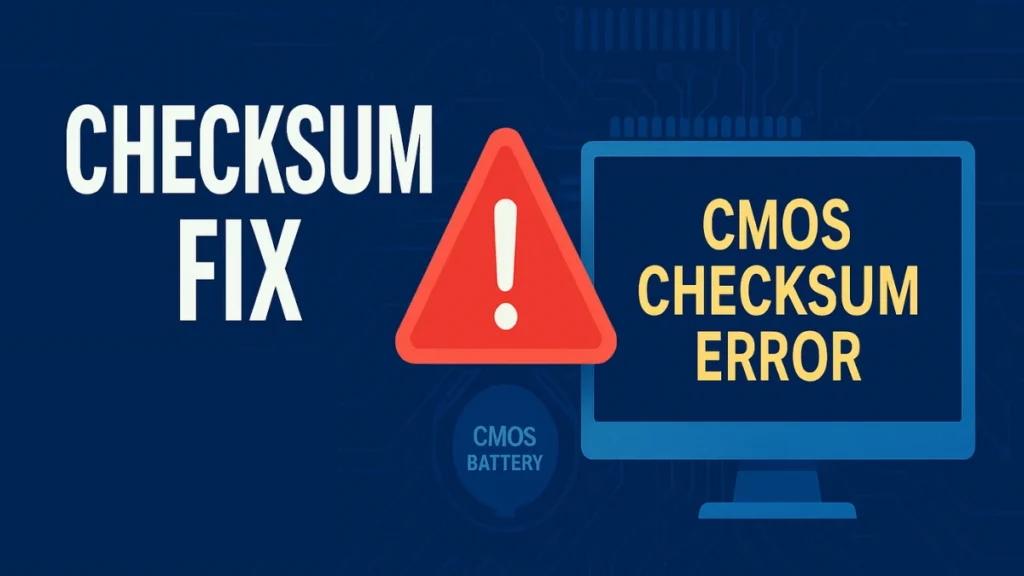A CMOS checksum error is a startup warning that typically appears immediately after your computer’s BIOS screen. It indicates that the configuration data stored in the motherboard’s CMOS memory has become corrupted or doesn’t match the checksum value used to verify it. When this happens, the BIOS loads default settings, signaling that something is wrong with the saved configuration.

Common Causes
- Dead or weak CMOS battery (most common) — CR2032 coin-cell battery has lost charge.
- Improper shutdowns or power loss — corrupts CMOS data.
- BIOS update failure — interrupted or incorrect update process.
- Outdated BIOS version — incompatibility with current hardware.
- Hardware changes — new devices added without BIOS reconfiguration.
- Malware or firmware tampering — rare, but possible.
- Motherboard fault — damaged CMOS chip or traces.
How to Fix CMOS Checksum Error
Here are all possible fixes — from quick software-level solutions to hardware repairs.
1. Restart the Computer
- Sometimes, an abrupt shutdown can cause a one-time error.
- Follow the on-screen prompt to restart.
- If it boots fine, avoid force shutdowns in the future.
2. Perform a Windows Startup Repair (Windows 10/11-specific)
This helps if the CMOS error is linked to boot issues.
- Press Windows + I → Update & Security.
- Go to Recovery → Advanced startup → Restart now.
- Select Troubleshoot → Advanced options → Startup Repair.
- Enter your account password and follow prompts.
3. Replace the CMOS Battery (Most Common Fix)
- Shut down and unplug your PC.
- Open the case and locate the CR2032 coin-cell battery on the motherboard.
- Remove it, wait 5–10 minutes, and insert a new one (positive side up).
- Boot into BIOS, set correct date/time, and save.
4. Reset the BIOS/UEFI to Default
If BIOS data is corrupted:
- Enter BIOS via Del, F2, or key shown on startup.
- Choose Load Optimized Defaults or Load Setup Defaults.
- Save & exit.
If you can’t access BIOS normally:
- Power on and force shutdown three times to trigger Windows Advanced Startup.
- Go to Troubleshoot → Advanced options → UEFI Firmware Settings → Restart.
- From BIOS menu, reset to defaults.
5. Update or Reflash the BIOS
- Check your motherboard manufacturer’s site for the latest BIOS.
- Follow instructions carefully — power loss during update can brick your board.
- Reconfigure BIOS after updating.
6. Verify Master Boot Record (MBR) Integrity (Windows-specific)
Rarely, a corrupted MBR can cause checksum-related boot errors.
- Boot into Windows Advanced Startup.
- Go to Troubleshoot → Advanced options → Command Prompt.
- Run:
bootrec /fixmbr
bootrec /fixboot
bootrec /rebuildbcd7. Check for Motherboard Damage
If the problem persists:
- Look for corrosion, bulging capacitors, or physical damage.
- If under warranty, contact manufacturer support.
- Consider motherboard replacement if repair isn’t viable.
How to Prevent CMOS Checksum Errors
While CMOS checksum errors can usually be fixed quickly, preventing them in the first place will save you time and avoid unexpected boot issues. Here are some best practices to keep your BIOS and CMOS settings stable:
- Replace the CMOS battery every 3–5 years to ensure the BIOS retains its settings.
- Avoid force shutdowns — always use the operating system’s proper shutdown procedure.
- Keep the BIOS updated to maintain compatibility with your hardware.
- Use a UPS (Uninterruptible Power Supply) to protect against power surges and sudden outages.
- Document your BIOS settings before making changes, so you can easily restore them if needed.
CMOS Checksum Error Quick Fix Table
| Problem | Likely Cause | Quick Fix |
|---|---|---|
| Clock resets | Dead CMOS battery | Replace CR2032 battery |
| One-time error after crash | Corrupted CMOS | Restart, then shut down properly |
| Persistent after BIOS update | BIOS data corruption | Reset or reflash BIOS |
| Boot errors after HDD change | MBR corruption | Repair MBR in Advanced Startup |
When to Seek Professional Help
Most CMOS checksum errors can be resolved at home, but certain situations require expert attention to prevent further damage. Consider contacting a certified technician if:
- The error appears immediately after replacing the CMOS battery and resetting the BIOS.
- A BIOS update has failed and the system no longer boots.
- There is visible damage to the motherboard, such as corrosion or burnt components.
A CMOS checksum error is a warning that your BIOS settings have been lost or corrupted, often due to a weak battery, power loss, or firmware issues. By following the steps in this guide — from replacing the CMOS battery and resetting the BIOS to performing Windows repairs — you can usually restore your system to normal operation. Taking preventive measures, like regular battery replacement and using a UPS, will reduce the chances of the error reappearing. If the problem persists despite your best efforts, professional repair is the safest path forward.
More Tech Guides
- 01How to Fix LiveKernelEvent Errors Causing Screen Flickering in Windows 10/11
- 02How to Fix CRITICAL_PROCESS_DIED BSOD Boot Loop in Windows 10 and 11
- 03Best PC Repair Utilities for Windows 11
- 04Best Driver Update Tools for Windows 11 (2026 Guide)
- 05How to Install Sysinternals Suite on Windows 10/11
- 06How to Fix Windows Blue Screen Error 0x000000000000010E After Hibernation
- 07Windows 11 Firewall Best Practices: 8 Ways to Secure Your PC
- 08Windows 11 Installation Has Failed Error: How to Fix Upgrade Problems

